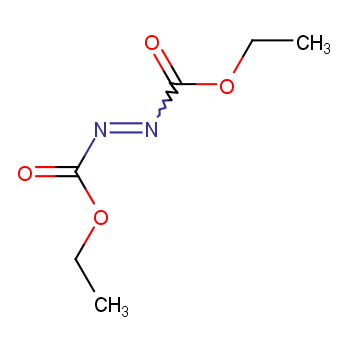 |
Diethyl azodicarboxylate (DEAD) is a thermosensitive orange liquid that is soluble in dichloromethane, ether, and toluene. It is sensitive to light, heat, and vibration, and can explode violently when heated.
The molecular structure of DEAD consists of a central azo functional group with two ethyl ester groups on each side. It is not only an efficient dehydrogenating agent but also a good electron acceptor. It participates in various chemical reactions such as the Mitsunobu reaction, Diels-Alder reaction, and Michael addition reaction. DEAD is an important liquid foaming agent that has good compatibility with plastics. Its decomposition products are colorless, odorless, and non-polluting. It can also be used in the synthesis of photosensitizers, polymer catalysts, fungicides, natural products, and pharmaceuticals.
Similar reagents include dimethyl azodicarboxylate (DMAD), diisopropyl azodicarboxylate (DIAD), di-tert-butyl azodicarboxylate (DBAD), 1,1'-(azodicarbonyl)dipiperidine (ADDP), and bis(4-chlorobenzyl) azodicarboxylate (DCAD).

DEAD can be obtained by alkylating hydrazine with ethyl chloroformate to generate hydrazine dimethyl ester, and then treating it with chlorine (through solution bubbling), hypochlorous acid, concentrated nitric acid, or red fuming nitric acid. The reaction should be carried out in an ice bath, with the reagent added dropwise and the temperature not exceeding 20°C.
Mitsunobu Reaction

The Mitsunobu reaction (also known as the photochemical extension reaction) is a bimolecular nucleophilic substitution reaction (SN2 reaction). Due to the electron-withdrawing effect of the ester group, the N=N double bond in DEAD is highly electrophilic and easily cleaved. In the Mitsunobu reaction, DEAD acts as a hydrogen acceptor.
Tributylphosphine reacts with azodicarboxylate to form a zwitterionic compound, which then abstracts a proton from the nucleophilic reagent, generating a nucleophilic anion. The alcohol then combines with phosphorus to form a phosphine oxide, while simultaneously releasing hydrazodicarboxylate. Finally, the nucleophilic anion attacks from the back of the alcohol, resulting in a configuration inversion product.


 |